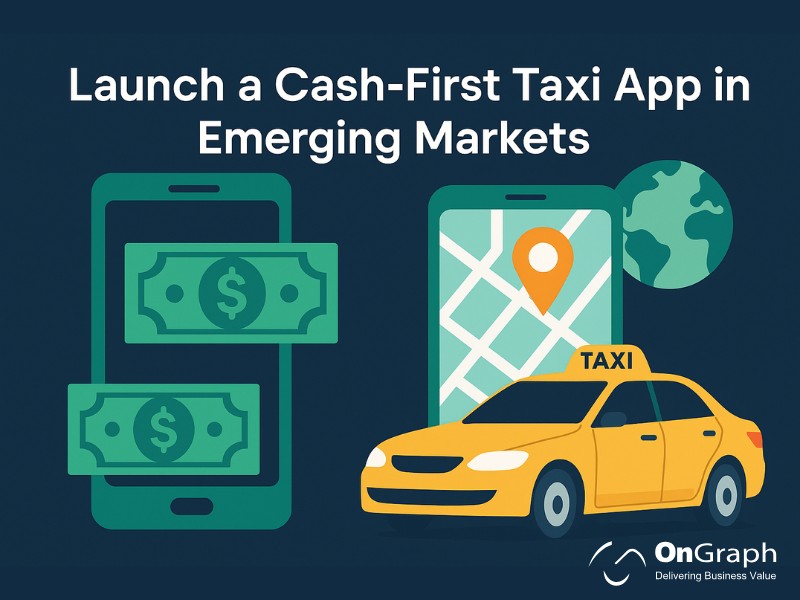In this article
- Why Cash-First Taxi Apps Matter in Emerging Markets?
- How Ride-Hailing Evolved in Developing Countries?
- Market Opportunity for Cash-First Taxi Solutions
- Essential Features for a Cash-First Taxi App
- How to Integrate Cash Payments With Digital Infrastructure?
- Technology Stack for Launching a Cash-First Taxi Platform
- Should You Choose a White-Label or Custom Build?
- Case Study: Cash-First Ride Adoption in Africa
- Steps to Launch a Cash-First Taxi App Successfully
- Final Thoughts
Launching a cash payment taxi app is one of the most effective ways to enter the mobility market in developing countries. Many users in emerging markets still rely on cash for daily transactions. They prefer simple, offline-friendly, and easy-to-use ride-hailing solutions. This makes a cash-first approach essential for gaining trust and building adoption in early stages.
This guide explains how to build and launch a successful cash-based transportation platform with real examples, updated statistics, proven features, and expert insights. You will also learn how the evolution of taxi apps influenced today’s market and why emerging economies demand specialized solutions.
Why Cash-First Taxi Apps Matter in Emerging Markets?
Cash is still the primary payment method in several regions. According to the World Bank’s Global Findex Report, more than 1.4 billion adults worldwide remain unbanked, with the highest concentration in Africa, South Asia, and parts of the Middle East. Many users do not trust digital payments or lack access to credit cards and digital wallets.
This creates a strong market need for a cash payment taxi app designed for riders and drivers who depend on physical currency. Cash also helps new platforms build early trust in regions where digital adoption is slow.
Key reasons cash ride-hailing dominates in emerging markets:
- Low credit card penetration
- High reliance on physical currency
- Limited digital infrastructure
- Strong preference for human interaction
- Need for instant confirmation and transparency
- Cultural comfort with cash on delivery ride-hailing
- Many drivers remain unbanked or semi-banked
These factors make cash-first mobility platforms an ideal fit for emerging markets ride-hailing environments.
How Ride-Hailing Evolved in Developing Countries?
The evolution of taxi apps began in developed economies where digital payments were already common. But in developing markets, the story unfolded differently. Operators learned that users preferred simple, reliable, and accessible systems.
A study on African mobility platforms found that more than 70% of riders choose cash as their primary payment option, even when digital alternatives exist. This demonstrates the necessity of a cash-based transportation app that works even with weak network connectivity.
Key trends shaping developing countries taxi solutions:
- Offline taxi booking app adoption
- Hybrid models: cash + wallet
- Need for low-cost onboarding
- Local language support
- Payment gateway flexibility
- High demand for phone-based customer support
- Growing interest in super-app ecosystems
The shift toward simplicity and accessibility opened doors for new innovators and for traditional taxi fleets wanting to modernize.
Market Opportunity for Cash-First Taxi Solutions
If you plan to launch a mobility startup focused on cash-first users, the timing is excellent. Consider these numbers:
- Africa’s ride-hailing market will surpass $7 billion by 2030.
- South Asia will reach over 200 million ride-hailing users by 2027.
- Cash-on-delivery remains the preferred payment method in 60% of mobility transactions across low-income economies.
This highlights a large and underserved market for a cash payment taxi app tailored for regions like Africa, Tunisia, India, Pakistan, Bangladesh, and rural LATAM.
Platforms that start with cash-first models often scale faster because they remove payment friction and build early trust.
Essential Features for a Cash-First Taxi App
Launching a mobility platform in emerging markets requires the right mix of core features and specialized tools. Below is a structured list of high-impact Taxi App Features for cash-first markets.
1. Cash and Hybrid Payments
- Cash as default payment
- Wallet for bonuses and future digital adoption
- Driver-side cash settlement tracking
- Offline cash collection for low-signal areas
This ensures smooth operation in regions where drivers and customers prefer physical transactions.
2. Offline Taxi Booking App Mode
Network connectivity is unstable in many areas.
An offline taxi booking app ensures:
- Ride requests are stored until the signal returns
- GPS works in low-connectivity zones
- Drivers can complete trips without internet drops
This feature boosts reliability and trust.
3. Driver Training and In-App Courses
Emerging markets often feature first-time digital users.
In-app lessons help drivers:
- Understand navigation
- Learn the app interface
- Follow customer safety guidelines
- Maintain service quality
Training improves retention and reduces support load.
4. Gamification for Driver Engagement
Gamification motivates drivers to stay active.
Key elements include:
- Loyalty points
- Weekly targets
- Time-based bonuses
- Achievement badges
Gamification is crucial to solving supply gaps and boosting productivity.
5. Multi-Language Support
Many users prefer local languages.
A Developing countries taxi solution must support:
- Regional languages
- Bilingual interfaces
- Automatically detected locale
This improves onboarding and accessibility.
6. Accurate Geofencing
Geofencing in taxi apps helps:
- Block unsafe areas
- Manage no-go zones
- Activate surge pricing
- Design pickup restrictions
This feature is vital in complex city environments with restricted or unsafe zones.
Also read- How Geofencing in Taxi Apps Enhances User Experience?
7. Essential Safety Tools
- SOS button
- Driver verification
- Number masking
- Emergency shortcuts
- Trip sharing
Safety builds trust and encourages adoption.
How to Integrate Cash Payments With Digital Infrastructure?
Even a cash-first app needs a digital backend. A smart payment system ensures transparency and smooth operations.
Components of a strong cash ecosystem:
1. Driver Cash Settlement Dashboard
Drivers can:
- Track daily earnings
- Record cash collected
- Report discrepancies
- View payout schedules
This reduces disputes.
2. Wallet and Reward System
Cash rides can convert into:
- Wallet credits
- Discount coupons
- Referral points
This bridges the gap between cash and digital adoption.
3. Taxi App Payment Gateway Integration
Some users will still prefer:
- Credit cards
- Local wallets
- Bank payments
- Regional payment APIs
Your app should support flexible Taxi App Payment Gateway Integration, even if cash is the primary mode.
Technology Stack for Launching a Cash-First Taxi Platform
A strong technical foundation ensures scalability, security, and reliability.
Recommended stack includes:
- Native Android + iOS apps
- Admin panel + dispatcher dashboard
- Real-time driver tracking
- Map SDK + GPS optimization
- Integrated wallet
- CMS for driver training
- Gamification modules
- Push notification system
- Cloud-based infrastructure
AI-backed modules such as AI in Taxi Apps enhance routing, fraud detection, and demand predictions. AI is optional at first but adds high value when scaling.
Should You Choose a White-Label or Custom Build?
You have two options to build your mobility platform. Each has pros and cons. Your choice determines cost, speed, and scalability.
1. White Label Taxi App for Multi-Service Platform
Fastest and cheapest way to launch.
Pros:
- Launch within 4–6 weeks
- Lower development cost
- Proven features
- Stable architecture
- Scalable for future services
- Option to add delivery or courier modules
2. Custom Build for Startups
Best for long-term ownership with unique features.
Pros:
- Complete control
- No feature limits
- Ability to design new flows
- Unique branding edge
Comparison Summary:
If you want fast market entry in a cash-first environment, choose a white-label solution. It reduces risk and provides predictable performance.
This aligns with standard guidance in White Label Taxi App vs Custom Build for Startups comparisons.
Case Study: Cash-First Ride Adoption in Africa
A recent study of African taxi app development revealed strong trends:
- 75% riders use cash as their main payment method
- 52% drivers prefer apps that do not force digital payouts
- Offline booking raised adoption by 30% in low-signal regions
- Local language apps had 40% higher retention
- Driver gamification increased weekly activity by 18%
These insights demonstrate a clear demand for a cash payment taxi app optimized for emerging markets.
Platforms that launch with simple cash-first systems gain rapid early traction.
Steps to Launch a Cash-First Taxi App Successfully
Here is a step-by-step guide to launching your platform in 2025.
Step 1: Validate Market Need
Study local:
- Payment habits
- Driver supply
- User preferences
- Competition
Step 2: Select the Right Taxi App Development Company
Choose a vendor with:
- Experience in emerging markets
- Strong white-label portfolio
- Payment flexibility
- Driver-focused features
- Offline ride support
Step 3: Build an MVP
Include:
- Cash payments
- Driver training
- Geofencing
- Multi-language support
- Gamification
Step 4: Integrate Local Payments
Even if cash dominates, prepare for future digital growth.
Step 5: Launch and Test
Release Android first to maximize local penetration.
iOS can follow as an option.
Step 6: Scale Into Multi-Service
After success, add:
- Food delivery
- Grocery delivery
- Courier services
Many startups aim to become multi-service platforms after establishing initial user trust.
Final Thoughts
A cash payment taxi app solves the biggest barrier in emerging markets: trust. Cash helps riders and drivers adopt digital mobility platforms without fear or friction. When combined with strong features, scalable architecture, localized content, and offline support, cash-first apps become powerful tools for transformation.
Emerging markets are ready for simple, reliable, and accessible mobility solutions. With the right strategy, strong UX, and the right development partner, you can build a sustainable ride-hailing business that serves millions of users.
FAQs
Many users do not use digital payments. Cash-first apps build trust and remove friction in adoption.
Yes. You can add wallets, cards, or local payment APIs through flexible gateway integrations.
The app stores ride requests locally and syncs them when the network returns. GPS keeps running offline.
Essential features include cash payments, offline booking, local languages, geofencing, training modules, and driver gamification.
A white-label solution is faster and cheaper. Custom builds are suitable for unique or large-scale needs.
A white-label launch takes 5–7 weeks. Custom builds take 3–6 months.
Yes, they scale fast in cash-dominant regions and allow phased digital adoption over time.
About the Author
Let’s Create Something Great Together!
Latest Blog















